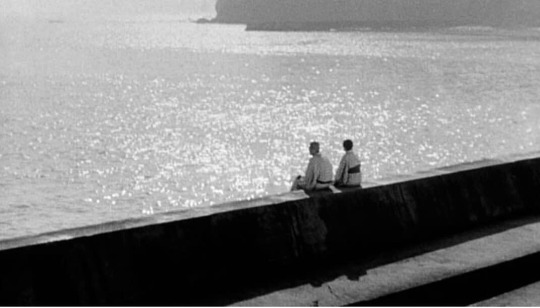#TokyoStory FilmReview
Text
Film Review of Tokyo Story (1957) by Yasujiro Ozu
Director: Yasujiro Ozu
Cast: Chishu Ryu, Setsuko Hara, Haruko Sugimura
IMDb: 8,2/10
Rotten Tomatoes: 100%
Review:
Tokyo Story is a home drama film that heavily centers around the appreciation of family. The entire movie follows the way a family lives together and at the same time how they live apart. An old couple, grandmother and grandfather, travel to Tokyo to visit their children and grandchildren after many years of not seeing them. The viewers witness a natural flow of living, the family taking part in the day-to-day activities like catching up about each other’s lives, doing chores, eating, traveling. The film aims to highlight the importance of bonding with family, it shows how satisfying it is when one does so through scenes like a mother-in-law and daughter-in-law enjoying each other’s company and conversations, or a grandmother enjoying watching her grandson play in the field. The film makes it clear that the excuse that most people make, that life is too busy or that one has to focus on their own individual life when they grow up instead of engaging with their family members is invalid. It illustrates the consequences of taking family for granted, mentioning that one cannot serve their parents beyond the grave. Time can go by quickly and unexpectedly, and before one knows it, regret heavily seeps in for not sharing enough cherishable moments with one’s family, and the fact that there are no more chances left can cause emotional turmoil.
The emotional tone of the film is quiet and tranquil, however, the feelings that are evoked are intense as the audience really starts to reflect on their own lives. The film leaves one questioning when last they called their mother just to tell them how much they love and appreciate them.
The shots in the film are predominantly still. This is in order to have every shot consisting of an exceptional composition of its own, as well as to engross the audience as scenes unfold gracefully and nothing distracts the viewer from paying close attention.
Tokyo Story is worth a watch. When you’ve watched it or if you’ve watched it, drop comments and share your thoughts and opinions.
0 notes
Photo

Aside from feeling sad and sorry for the two old couple because their children "drifted away" from them, this film is a great visual methapor for changing Tokyo (or Japan in general) after World War II. The emotional empathy, mise-en-scène, the story, the layers, its direction, and the patience, as well as other elements are all in harmony. Truly, this is a masterpiece of Yasujiro Ozu. P.S. Daghan jud kog mahunahunaan aning salidaha uy. From your aging parents, your siblings, your status, the sunrise, death, maskin bangka apil. Maka contemplate jud kag taman taman. 😁 #Yaduing #TokyoStory #filmreviews #filmcriticism #JapaneseFilms https://www.instagram.com/p/CCXkZI5n082/?igshid=1j46krhdkb482
0 notes
Text
From the Iris of Yûharu Atsuta
Name of Film: Tokyo Story (1953)
Director: Yasujirō Ozu
Starring: Chishū Ryū, Chieko Higashiyama, Setsuko Hara, Haruko Sugimura, So Yamamura
Genre: Drama
From the exposition of the film we are immersed into cinematographer Yûharu Atsuta’s world of framing. He creates frames within frames of the screen, using this tool effectively in creating depth of fiend within his diegesis. The technique which Atsuta uses works well in coordination with Yasujirō Ozu’s blocking of the scenes.
Atsuta is very precise when coming to his placement of characters in accordance to the rule of thirds. He uses this type of framing to keep most of the characters’ locomotion in the center of the frame. The characters are mostly seated so he had to setup the camera at a much lower height than normal and film the actors at a low angle so the audience can still see then at eye level. In most cases he films his subjects in a long shot. The advantage of this shot is that it has a larger depth of fiend, and it also allows for movement in the background as well as caters for the characters in focus to be able to stand if required to in the scene. In most cases of the film Atsuta uses high key lighting, which has it advantages and disadvantages. It allows for more visibility of elements and objects in the frame. It’s does not add a dramatic way in which you see the characters so they have to rely more on their acting to convey and evoke emotion. The unfortunate part is that we have less shadows on the surfaces and on the characters, material also looses its texture. Most of his shots are on a tripod and are stationary. He only does two camera movements in the entire film which is a right pan and a tracking shot.
The main theme in the film is romance following the story of an elderly couple who visit their children. Their relationship’s challenges teaches viewers a lot about the importance of patience in a relationship, and the essential need for one to understand their partner just as they understand themselves.
Tokyo Story is a film that carries morals that people still live upon today, but has lost its touch with the youth. The naturalistic feel that the actors portray makes the film very believable in realistic context. The blocking was perfectly planned and the continuous takes are a pillar to the work of the director, actors and cinematographer
0 notes